Learn how to make homemade tamarind paste from scratch with simple steps for bold, sour flavors perfect for curries, sauces, and more!

Table of Contents
Jump to:
- Bold & Sour Flavor
- Tamarind of Africa
- Versitle Tamarind Paste Use
- Tamarind Paste Benefits
- Where to Buy Tamarind Paste?
- Ingredients with Steps
- Culinary Glossary
- Difference Between Tamarind Pods, Pulp, Block, and Paste
- Instructions with Pictures
- Substitutions
- Equipment
- Storage
- How to Preserve Tamarind and Tell If It’s Gone Bad
- Cooking Tip
- Frequently Asked Questions
- Asian-Inspired Recipes
- Sauce Recipes
- Cook's Notebook
- 📖 Recipe
- Subscribe to the YouTube Channel
- Have a Comment or Question?
Bold & Sour Flavor
Tamarind paste is one of my go-to ingredients for adding a bold, sour flavor to my cooking. If you’ve never worked with tamarind before, think of it as a tangy, slightly sweet ingredient that’s essential in many global cuisines.
Today, I’m going to show you how to make homemade tamarind paste from a tamarind block so you can have it on hand whenever you need it for dishes like Pad Thai or dipping sauces. It’s incredibly versatile and easy to make!
Tamarind of Africa
Tamarind is native to tropical Africa, though it has become widely cultivated throughout Southeast Asia, India, and beyond. In India, tamarind plays a key role in many dishes, especially in South Indian cooking, where its tart flavor is used to balance rich curries and chutneys.
Turning tamarind into a paste has been a common practice for centuries, making it easier to store and use as a souring agent in both sweet and savory dishes. Looking for authentic Southern Indian recipes? Check out Swasthi's Recipes and Dassana's Veg Recipes.
t’s incredibly versatile and easy to make!
Versitle Tamarind Paste Use
Tamarind paste is a kitchen essential for adding that signature sour taste to various dishes. Whether you’re making Indian food, like a tangy tamarind dipping sauce, or whipping up a traditional Pad Thai (my favorite!), tamarind paste elevates everything. It’s also fantastic in steak sauces, salad dressings, or even as a glaze. The versatility of this tart flavor makes it a must-have!
Thai Food Use
Thai cuisine is one of my absolute favorites! I love making everything from Pad Thai to green and red curries—the flavors are so vibrant and well-balanced. Tamarind paste is a key ingredient in many Thai dishes, bringing that perfect mix of sweet and sour.
If you’re as big of a fan of Thai food as I am, I’d love to hear about your favorite Thai dishes—share them with me! Looking for authentic Thai recipes? Try Hot Thai Kitchen and Hungry in Thailand.
Tamarind Paste Benefits
Not only does tamarind paste bring a bold, sour flavor to your dishes, but it also comes with a host of health benefits. It’s packed with antioxidants, vitamins, and minerals. Tamarind has long been used in Indian cuisine and traditional medicine to aid digestion and reduce inflammation. So, it’s not just tasty—it’s good for you too!
Where to Buy Tamarind Paste?

You can find tamarind paste at most Asian grocery stores; I suggest going there first. I've also learned that Indian tamarind concentrate and Thai tamarind paste are different, as mentioned by Chef Pailin "Pai" Chongchitnant of Hot-Thai Kitchen. She actually gave me the confidence to make homemade tamarind paste from a tamarind block. So it is important to buy the one that matches the cuisine.
Indian tamarind concentrate and Thai tamarind paste
Another good note I learned from her when it comes to buying global ingredients is to buy from the place where the cuisine you are preparing is from. This way, you have a better recipe outcome. You can easily check the back label to see if it was made in Thailand or India.
If not, check out your local grocery store, especially in the international or Asian food aisle. If you’re shopping online, I recommend looking for top brands like Tamicon Tamarind Concentrate for Indian food or Thai Taste Tamarind Paste for Thai food on Amazon.
Both are available on Amazon to get close to that authentic tamarind concentrate paste with the desired tartness flavor for your recipes. Stock up in a glass jar, and you’ll always have it ready!

Hey! I used this homemade tamarind paste for my Grilled Pork Chops with Tamarind Habanero Glaze and Coleslaw recipe.
More Delicious Recipes to Try
- Shrimp and Pork Belly Pad Thai - Spring Roll Style
- Beef Flavored Seaweed Ramyun with Egg and Gochujang
- Spicy Moroccan-Inspired Harissa Carrot Salad
- Easy Sheet Pan Spicy Miso Salmon Rice Bowl
Ingredients with Steps
To make tamarind paste from a tamarind block, first, cut the block into smaller pieces and soak them in warm water (or hot water for a quicker process) for about 30 minutes.
Once softened, use your hands or a spatula to mash the tamarind, releasing all the pulp. Next, strain the mixture through a fine mesh strainer (sieve) to remove the seeds and fibers. What remains is your tamarind paste! Store it in a glass jar in the fridge for later use.
Culinary Glossary
This section provides concise definitions of key ingredients and techniques to enhance understanding and improve cooking skills related to this recipe.
- Tamarind Block - Compressed tamarind pulp, seeds, and fibers, usually sold in Asian and Indian grocery stores.
- Tamarind Concentrate - A highly concentrated form of tamarind paste, often used in Indian cuisine.
- Tamarind Flavor - A sharp, sour, tangy taste.
- Sieve: A fine mesh tool used to separate pulp from seeds and fibers.
See the tamarind paste recipe card for quantities below.
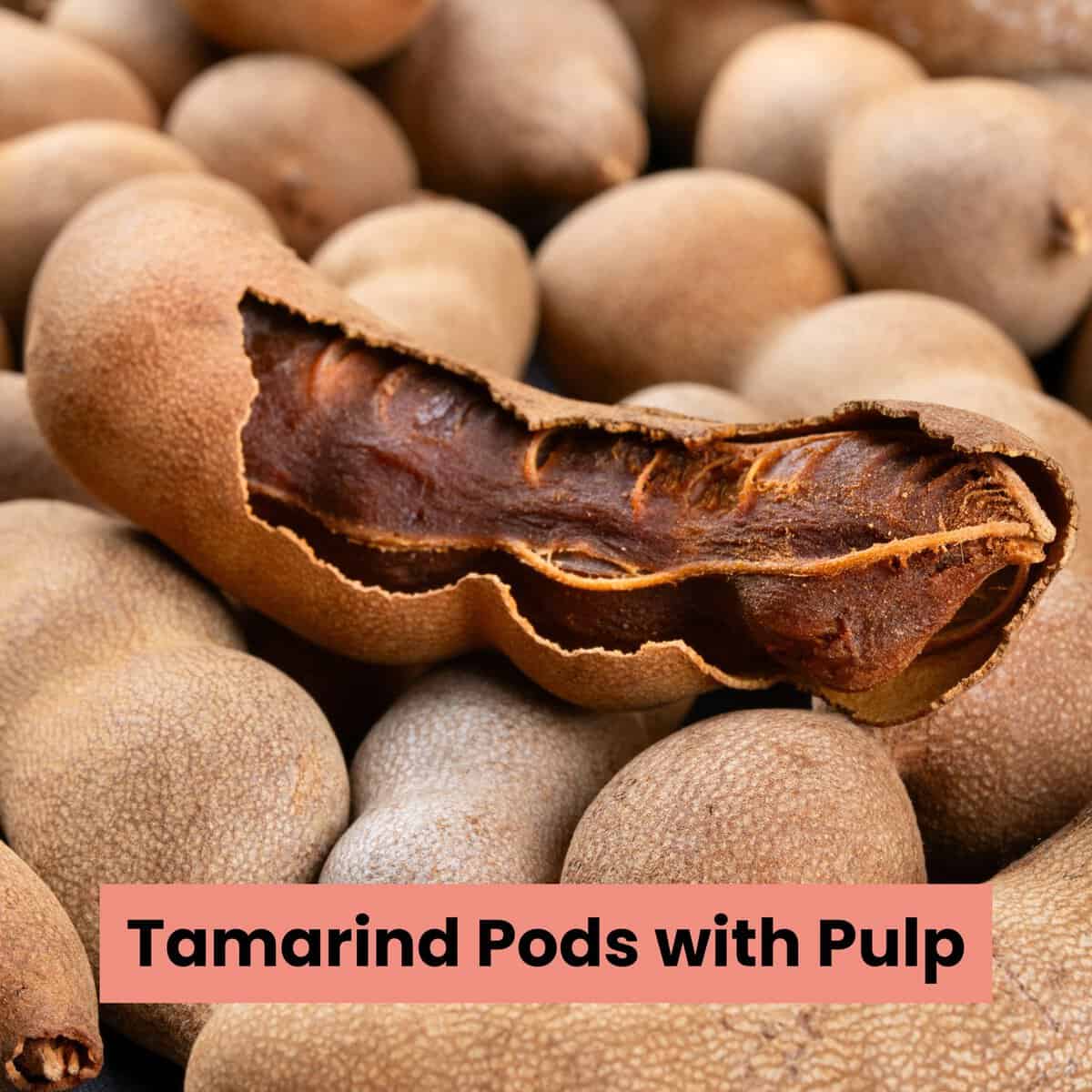

Get the Asian Best tamarind brand if you can find it for Thai food.
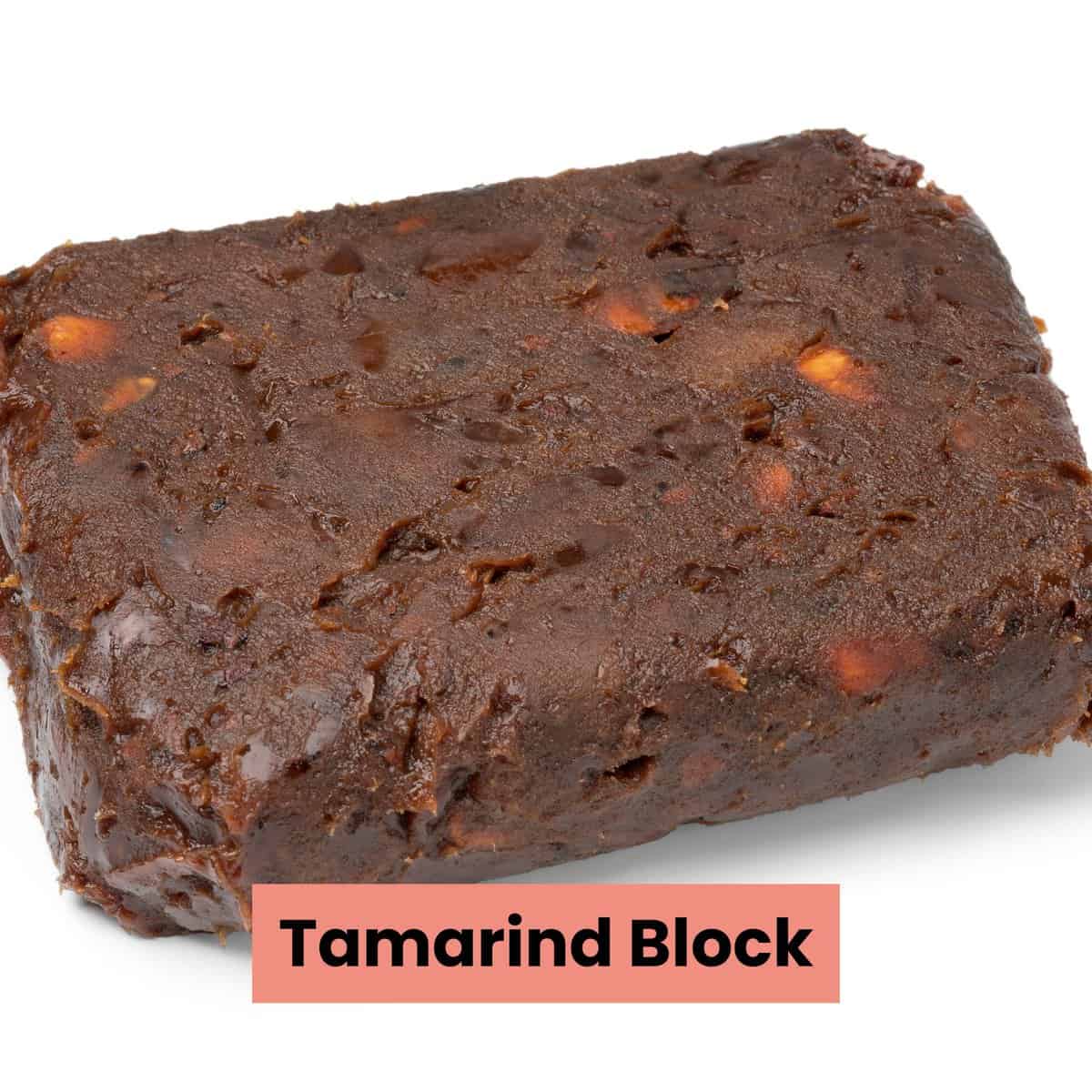
Difference Between Tamarind Pods, Pulp, Block, and Paste
Tamarind comes in many forms, from the whole pod to pulp, block, and paste.
- Fresh tamarind pods come in a hard shell, tend to have a sweeter taste, and, with an edible pulp, can be eaten straight or turned into pulp.
- Tamarind pulp is more concentrated.
- Tamarind blocks are compressed versions of that pulp.
- Tamarind paste, which you can buy or make from a block, is the most convenient form to use in recipes.
How to Peel Tamarind Pods and Eat Them
Peeling tamarind pods is easy! Simply crack open the brittle outer shell, then gently pull out the sticky flesh inside. You can eat it as is or use it to make tamarind pulp. Just be careful of the seeds inside, which are not edible!
Instructions with Pictures
Follow the instructions and cooking tips below using the step-by-step picture guide.

Here's a cross-section of the tamarind block where you can see the rough fibers.

It is usually wrapped in a plastic film.
My Rating: ⭐⭐⭐⭐
Purchased: December 10, 2023
My Review: I love the clean, classic look of this Pyrex 3-piece glass mixing bowl set—it’s a staple in my kitchen. Pyrex is known for its durability, and these bowls definitely live up to that reputation. I use them for everything from mixing batters to storing leftovers, and the fact that they’re microwave-safe makes them super multifunctional. They’re also easy to clean and stack nicely in the cabinet. The only reason this isn’t a five-star for me is because I always have that little fear of breaking them when I’m using or storing them, even though they’re made to last.

Cut or tear the tamarind block by hand into smaller pieces.
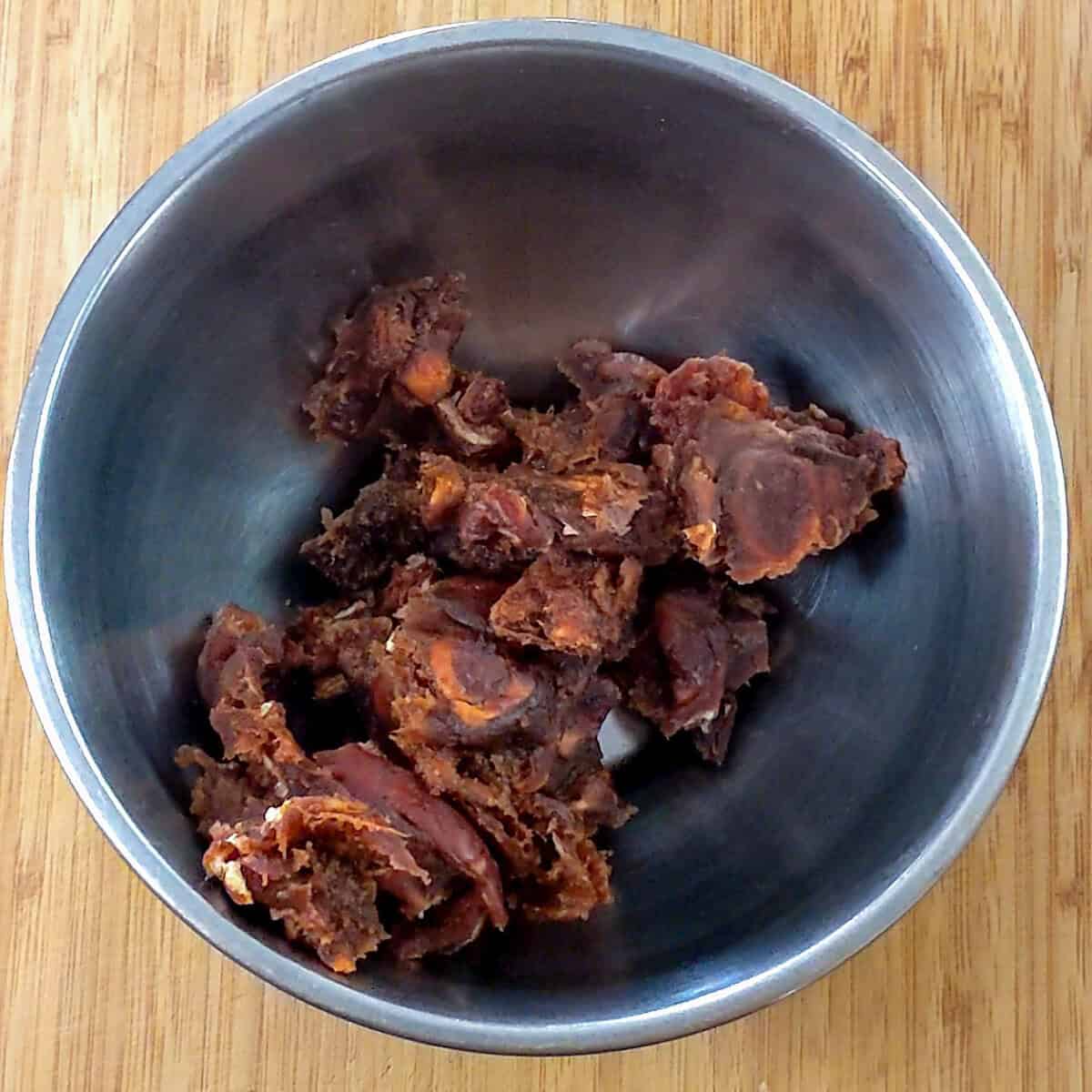
Then, place them in a bowl big enough for when they are covered with water.

Soak pieces in warm water for 30 minutes.

After 30 minutes, you will notice a difference in color. The item becomes lighter and swells as it absorbs liquid.
My Rating: ⭐⭐⭐⭐⭐
My Review: The Cuisinart 1.7-liter Stainless Steel Cordless Electric Kettle has become a favorite in our kitchen. I love the sleek stainless steel design—it looks great on the counter and feels sturdy and well-made. It’s so much more convenient than dirtying a pot just to boil water, especially with the 6 preset temperature settings that make it easy to get the perfect heat for everything from tea to oatmeal. Even my husband uses it regularly to make matcha at just the right temp, which says a lot! It’s fast, efficient, and one of those appliances you didn’t realize you needed until you have it.

Mash the tamarind to release the pulp.

You want to keep mashing the pulp until the liquid is absorbed.
My Rating: ⭐⭐⭐⭐⭐
Purchased: 01/01/22
Update: 10/16/24
My Review: I highly recommend the ForPro Professional Collection Disposable Nitrile Gloves. They’re food-safe, powder-free, and latex-free, making them perfect for cooking. I’ve ordered these several times and use them both personally and for my videos. The gloves are durable and chemical-resistant, offering excellent protection while handling raw ingredients. When pressed for time, they’re my go-to for preventing cross-contamination without needing to wash my hands constantly. A must-have for any busy kitchen!

Strain the mixture to remove seeds and fibers.

Running it through the strainer will create a smoother consistency.
My Rating: ⭐⭐⭐⭐⭐
Purchased: 06/06/23
My Review: As a chef with over two decades of experience relying on All-Clad, their D3 Stainless 3-quart saucepan is a kitchen workhorse. The sturdy 3-ply construction ensures even heat distribution for perfect simmering, searing, and everything in between. It's a breeze to clean, goes effortlessly from stovetop to oven, and consistently delivers exceptional results for rice, soups, sauces, and more. This saucepan is a worthy investment if you're looking for durable, versatile, and American-made cookware.

Using hands helps to feel the difference between the pulp and fibers.

The remaining fibers and seeds will be left behind.

You can also use a flexible spatula for this process.

Now you have tamarind paste.

For longer preservation, heat it to kill pathogens that can cause it to go bad.

The color will change to a darker color, which is probably due to the sugars caramelizing.
My Rating: ⭐⭐⭐⭐⭐
Purchased: 03/12/24
Update: 10/16/24
My Review: I've currently switched to the ThermoWorks Hi-Temp Silicone Spatula, and it's been great. The fact that it's all silicone makes it easy just to throw it in the dishwasher and ensures that it will last a long time. It is well made, and the tip is super thin; I was afraid it would crack, and it has not yet.

Store the tamarind paste in a glass jar in the fridge.
Substitutions
Dairy-Free
- Yay! No dairy products are found or used in tamarind paste. So, you are good to go!
Gluten-Free
- Bonus! It's gluten-free, too.
Vegetarian
- Triple Threat! LOL. Also, vegetarian. Excellent for plant-based meals.
Convenience
Tamarind Substitutes - You can mimic tamarind paste if you are in a pinch and use what you may already have at home.
- Lemon juice mixed with a little brown sugar.
- Apple cider vinegar with a touch of honey.
- Lime juice for a more citrusy, sour taste.
- Pomegranate molasses for a tart and sweet flavor.

Fun Fact! Did you know Worcestershire sauce contains tamarind?
Equipment
- Mixing Bowl: Used to soak the tamarind block and mix the paste. I used a Cuisinart Stainless Steel Mixing Bowl.
- Spatula: Perfect for mashing and mixing the tamarind to release the pulp. Try the OXO Good Grips Silicone Spatula.
- Strainer (Fine Mesh Sieve): Essential for separating the seeds and fibers from the paste. A strainer is an essential tool in the kitchen; learn more.
- Sauce Pan: Used to heat the tamarind paste for certain recipes. For this recipe, I used the All-Cladd Stainless Steel Sauce Pan.
- Gloves: Helpful when handling tamarind to avoid sticky hands, I use the Food-Safe Nitrile Gloves.
Kitchen Must Haves - Find other tools I use here.
Storage
- Refrigerator - Store tamarind paste in an airtight container for up to 2 weeks.
- Freezer - Freeze tamarind paste in portions for up to 6 months. First, freeze them in ice cube trays, remove them, and place them in a resealable freezer bag.
- Reheating - Simply let the tamarind paste come to room temperature or warm gently in a pot.
How to Preserve Tamarind and Tell If It’s Gone Bad
To preserve tamarind paste, store it in a glass jar in the fridge or freeze it in small batches. You’ll know tamarind has gone bad if it develops an off smell, mold, or changes color. When in doubt, throw it out!
Airtight Food Containers
I interchange glass food storage containers with plastic clipping lids or wooden push-ins. I always suggest glass storage containers because they can be microwaved, they hold food without staining, and the glass keeps the food at a more stable temperature, keeping it fresher and longer. Try the OXO Good Grips Smart Seal Glass Rectangle Food Storage Containers or the Pyrex Freshlock Glass Food Storage Containers.
Cooking Tip
Your Cooking Tips Resource Guide - Become a better home cook with tips to help you cook more efficiently on the Cook's Notebook tab.
For a richer flavor, cook the tamarind paste with a little sugar or honey before using it in your dish.
Frequently Asked Questions
Yes! Just be aware that tamarind concentrate is stronger, so you’ll need to adjust the amount accordingly. It is mainly used in Indian cuisine.
Tamarind paste is smoother and ready to use, while tamarind pulp contains seeds and fibers that need to be strained out.
Absolutely! Tamarind paste is a key ingredient in Indian cuisine, especially for chutneys, curries, and South Indian cooking.
Yes, tamarind paste adds a tangy, sour flavor that’s great for steak sauces and marinades.
Tamarind paste is available in most grocery stores or online through Amazon, with brands like Tamicon or Thai Best offering great options. Learn More.
Asian-Inspired Recipes
Looking for Asian-inspired recipes like this? Try these:
- Quick Spicy Potstickers | Chili Momo Tibetan Style
- How to Make Multigrain Rice | Purple Rice Recipe
- Lemongrass Marinated Grilled Chicken Spring Rolls
- Easy Sheet Pan Spicy Miso Salmon Rice Bowl
Sauce Recipes
Looking for other sauce recipes like this? Try these:
- Green Seasoning Recipe | Epis - Haitian Style
- Creamy Lemon Greek Yogurt Dressing | Easy 5-Minute
- Habanero Tamarind Glaze | Sweet, Spicy, and Tangy
- Creole Tomato Sauce Recipe | Easy Spicy Haitian-Inspired
Cook's Notebook
Get more resources about ingredients, cooking techniques, and equipment.
- How to Trim and Slice Collard Greens (Step-by-Step Guide)
- How to Clean Collard Greens | Step-by-Step
- How to Cook with Sweet Peppers: Flavor Pairing to Avoiding
- How to Chop Onions Without Crying (Quick Method)
📖 Recipe
Homemade Tamarind Paste
Ingredients
- 1 200 grams block of tamarind
- 2 cups warm water
Equipment
Instructions
- Save time in the kitchen: Read the instructions thoroughly, then gather and prep all your ingredients before cooking! Learn Prepping Tips.
- Prep the Tamarind Block: Cut the tamarind block into smaller chunks to make it easier to work with.
- Loosen the Pulp: Soak the tamarind pieces in 2 cups of warm water for about 30 minutes. Let the tamarind soften completely.
- Separate Pulp from Seeds and Fibers: Break and mash the tamarind with your hands or a spatula, breaking apart the pieces and releasing the pulp into the water. Strain the mixture through a fine-mesh strainer to remove seeds and fibers, pressing down with a spoon or spatula to extract as much pulp as possible.
- Preserve the Rest: Store the tamarind paste in an airtight container or glass jar. It will keep in the refrigerator for up to 2 weeks, or you can freeze portions for up to 6 months.
Video
Nutrition
Subscribe to the YouTube Channel
SUBSCRIBE: 👈To my YouTube Channel to Get Notifications of New Videos.
Have a Comment or Question?
If you have a question or comment about this recipe, please post it below. You will definitely get a quick response. It also helps our other readers to stay informed. Thanks!





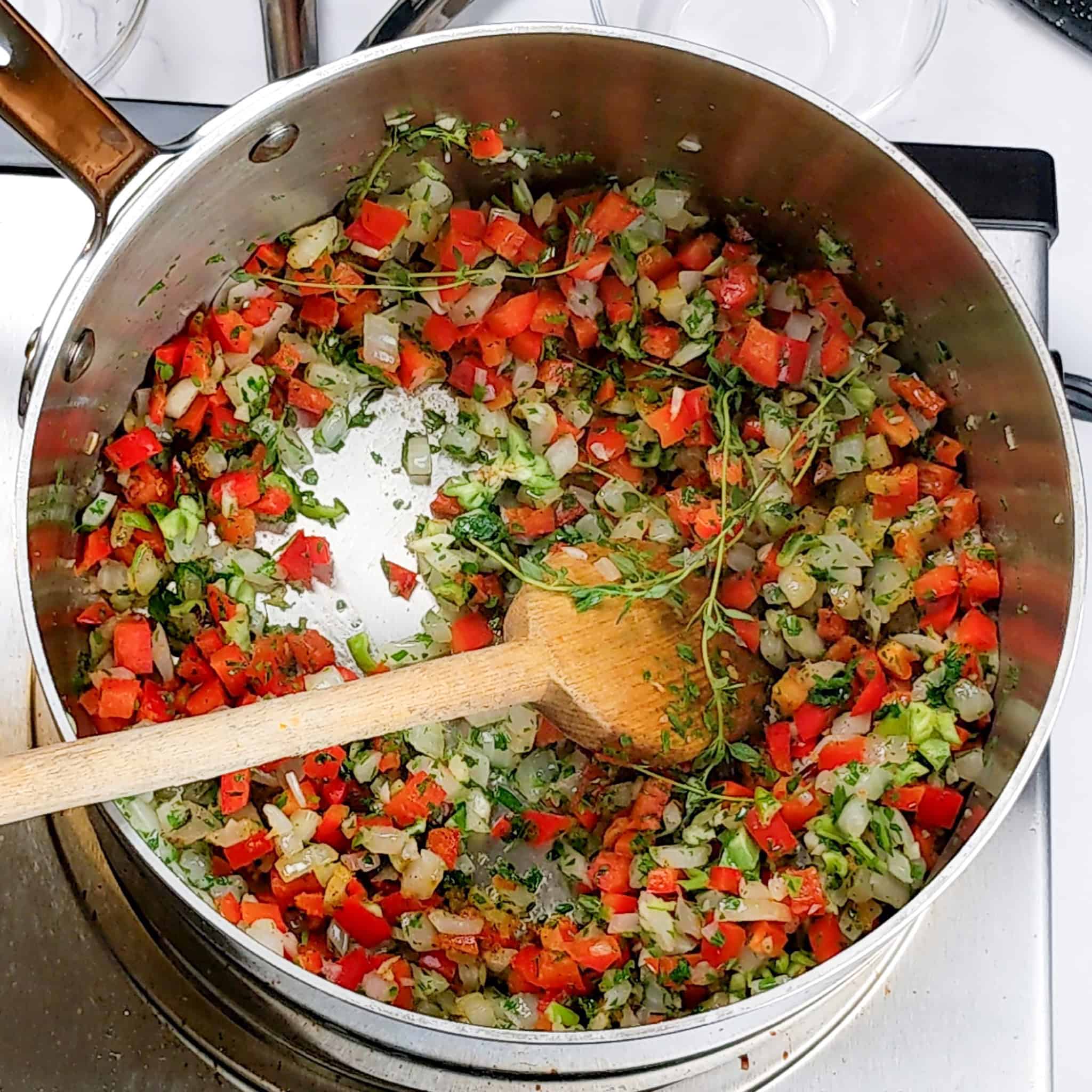















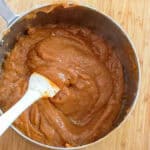




Leave a Reply